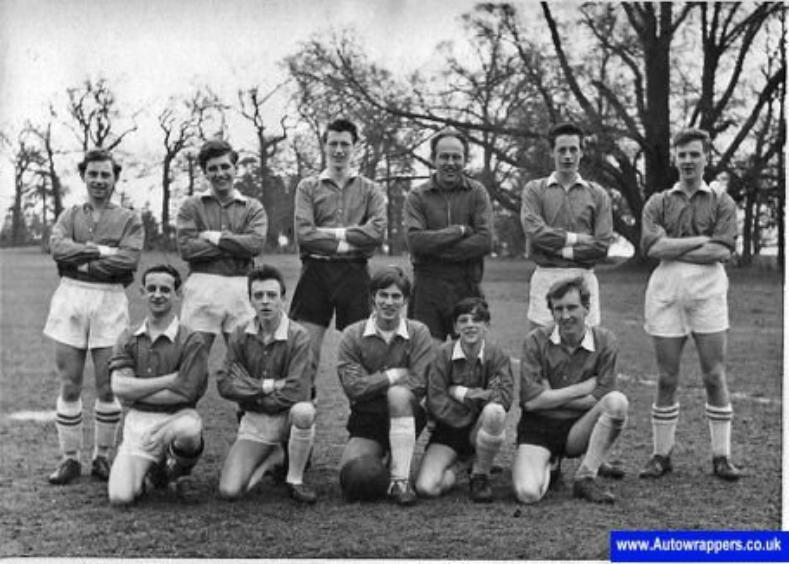






Posted 26-3-16
Working at the Edward Street factory, as told by Rod Horne
Hello I am Rod Horne
I came upon this site through Facebook and thought this may be of interest.
I
served
an
engineering
apprenticeship
at
Auto-Wrappers
when
they
were
based
at
Edwards
Street,
Norwich.
I
was there from September 1958 until July 1964.
Charlie
Maddison
was
top
man
with
his
brother,
Reg
in
a
senior
foreman
or
work’s
manager
type
of
role.
There
were
4
foreman
as
I
recall,
Jack
Robinson
who
was
foreman
of
the
‘R’
(Roll
Wrapper)
machine
assembly
bay;
Bert
Goodings,
foreman
of
the
other
bay
which
assembled
a
range
of
machines
designed
to
wrap
biscuits,
toilet
soap,
toilet
rolls
etc.
(Bert
was
my
foreman
and
I
remember
machine
classifications
such
as
‘RB’
(for
round
biscuits),
‘WL’
and
‘WWL’
etc.
-
pretty
much
anything
that
wasn’t
an
‘R’
(
Roll
wrap
machine);
Ray
Sexton,
the
machine
shop
foreman.
The
fourth
foreman’s
name
escapes
me
but
he
was
responsible
for
all
the
odds and sods, labourers, packing crate makers, and possibly the plating shop etc.
There
was
another
man
in
a
position
of
authority,
perhaps
on
a
par
with
Reg
Maddison
or
even
greater,
but
I
can’t
recall
his
name
at
all
(possibly
Robson??)
but
I
do
remember
him
being
a
mean
spirited
person.
The
workshops
at
Edwards
Street
were
utilitarian
in
construction;
single
storey
with
concrete
floors,
glass
roofs
with
brick
and
asbestos
walls.
During
the
severe
winter
of
1962/63
it
was
not
unusual
to
arrive
at
work
to
find
the
temperature
in
the
factory
to
be
about
3
C
(38
F).
The
Factory
Act
of
that
time
said
it
should
be
a
minimum
of
20
C
(68
F)
within
1
hour
of
starting
work;
with
AW’s
heating
system
and
the
extreme
cold
this
was
never
going
to
be
on.
When
requests
were
made
to
this
man
to
have
the
heating
left
on
over-night
his
response
was
“Tell
them
to
wear
more
clothes
and
work
harder!”
However,
there
was
so
much
unrest
and
ill-feeling
that
eventually
this
request
was
agreed
to.
In
addition,
wooden
duck
boards
were
provided
for
all
the
benches,
until
then
we
had
stood
on
the
cold
concrete,
During
the
summer
months,
the
low
roofs
made
it
unbearable
for
the
opposite
reason!
During
this
period
of
extremely
cold
weather,
Ken
Calinski
(one
of
maybe
4
or
5
Polish
men
who
worked
at
AW
(and
probably
left
over
from
the
war)
told
us
that
it
had
been
even
colder
when
he
escaped
from
Poland
to
avoid
the
German
army
and
had
waded
chest-deep
across
a
fast
flowing
river!
Another
of
the
Poles,
Joe
Lesnik,
would
occasionally
visit
his
relations
in
Poland,
as
did
some
of
the
others,
Ken
never
did.
He
also
never
spoke about his early life so we wondered what he had experienced before coming to England.
Under
the
foremen
were
several
leading
hands;
Stan
Ablett,
who
would
take
the
apprentice
boys
under
his
wing
until
they
moved
to
other
work;
Ken
Calinski.
Jack
Thorn,
John
Plumstead,
(John,
I
believe,
was
to
become
foreman
of
a
development
section
to
be
set
up
later),
Jack
Nixon
who
was
in
charge
of
the
gang
making
small
detail
parts,
and
in
the
jig
and
tool
shop
there
was
another,
Arthur
Wilson.
There
were
others
but
it was a long time ago and my memory is not that good.
Arthur
Wilson,
of
jig
and
tool,
was
a
Communist
and
the
A.E.U.
representative
(A.E.U,
the
Association
of
Engineering
Workers).
Arthur
was
always
treading
on
management’s
toes
and
for
some
reason
was
given
the
sack,
which
gave
rise
to
the
first,
and
perhaps
the
only
strike
of
the
AW
work
force.
This
must
have
been
late
’63/’64
as
I
was
one
of
the
strikers
so
must
have
finished
my
training,
apprentice
boys
not
being
allowed
to
strike. After a week of striking, Arthur was re-instated.
I
mentioned
the
assembly
shops
and
their
rough
working
conditions
but
these
were
palatial
when
compared
to
the
machine
shop.
This
was
Ray
Sexton’s
domain
but
he
worked
with
what
he
was
given.
The
toilets
were
poorly
lit,
dirty
and
very
smelly.
It
was
my
job,
as
the
youngest
apprentice
in
the
machine
shop,
to
wash
the
tea
mugs
of
the
machine
operators
in
this
filthy
hole.
To
get
them
‘clean’
in
the
half-light
was
not
easy
and
there
were
frequent
complaints.
Also
stored
in
the
toilet
was
a
40-gallon
(200L)
drum
of
cutting
fluid.
This
was
pumped
into
a
bucket
and
then
diluted
before
being
used
on
the
lathes,
milling
machines
etc.
as
a
coolant.
It
was often splashed over the floor adding to the ambiance of the place.
The
machine-shop
was
a
hotchpotch
of
machines;
5
or
6
center
lathes
of
different
sizes,
3
or
4
capstan
lathes,
a
planer,
a
shaper,
several
milling
machines,
a
radial
drill,
a
vertical
borer.
The
planer
was
a
machine
from
yesteryear,
probably
the
1930s!
It
rattled
and
clanked
its
way
at
one
end
of
the
workshop
and
was
overseen
by
an
old
boy
of
Corporal
Jones
vintage
who
constantly
smoked
a
small,
soot-blackened,
burned
pipe.
He
was
also
responsible
for
the
case-
and
oil-hardening
of
small
components.
This
required
him
to
heat
the
parts
in
a
small
furnace
to
near
white-hot
temperatures
and,
in
the
case
of
oil-hardening,
plunge
them
into
a
tank
of
oil.
This
would
fill
his
area
with
clouds
of
smoke
which
would
eventually
make
its
way
throughout
the
shop,
gathering in clouds under the roof. At times it was like working in a fog, a hot oil-smelling fog.
We had our share of characters too.
One
of
the
capstan
lathe
operators
was
one
“Yorkie”
Marks,
a
man
who
didn’t
take
life
too
seriously.
On
Friday
afternoons,
just
before
we
left
off,
all
operators
were
given
30
minutes
in
which
to
clear
their
machines
of
swarf,
and
clean
and
oil
all
slides
and
hand-wheels.
During
the
day
I
had
lent
my
oil
can
to
a
lorry
driver
who
for
some
reason
had
filled
it
with
petrol.
When
it
was
returned,
unbeknown
to
me,
it
hadn’t
been
emptied.
I
had
forgotten
this.
“Yorkie”
had
filled
an
adjacent
waste
bin
with
swarf
from
his
machine
and
wiped
down
the
slides
etc.
He
then
asked
to
borrow
my
oil
can
and
oiled
the
surfaces.
On
smelling
the
petrol
he
poured
the
contents
(much
less
than
a
half
a
litre)
into
the
same
bin
as
the
swarf,
which,
because
there
was
so
much,
was
like
a
giant
Brillo
pad.
When
his
cleaning
was
done,
“Yorkie”
lit
up
a
cigarette
and
threw
the
match
into
the
waste
bin
whereupon,
with
a
great
whoosh
of
flame,
the
petrol
ignited.
The
heat
burned
off
the
coolant
on
the
swarf
and
a
great
cloud
of
white
smoke
rolled
up
to
the
ceiling!
The
oil
and
petrol
covered
slides
also
ignited
but
the
whole
thing was over in no time at all leaving us all in stitches and “Yorkie” looking shocked.
In
the
assembly
shop
was
Bob
Bull
who
worked
on
the
‘R’
machines.
These
machines
had
an
aluminium
hand
wheel
which
went
struck
with
a
spanner
rung
just
like
a
bell.
Bob’s
father-in-law
was
a
river
pilot
who
would
take
control
of
the
coasters
which
plied
their
trade
in
the
port
of
Norwich
and
guide
them
to
their
berths.
I
think
this
had
become
part
of
Bob’s
psyche
because
at
the
start
and
end
of
shifts
Bob
would
‘ring’
one
of
the
hand
wheels calling out “All ashore who’s going ashore.’
This picture below is the Autowrappers Football Club from 1962
The players are back row from left to right
1,
Ray
Cox
(captain
&
secretary)
2,
David
Crisp
3,
Kenny
Clarke,
4,
Alan
Bunn
(Ray’s
brother-in-law)
5,
Brian
Crome and 6, Derek “Timber” Linse
Front from the left to right
7,
Alwyn
Gant,
8,
Alan
‘Jimmy’
MacDonald,
9,
Barry
Moore,
10,
Pennington
??
and
me
....
11,
Rod
(Fred)
Horne.
Editors note: if anyone can help with filling in the ?? for Number 10 it would be appreciated
We
were
contacted
by
David
Crisp
to
say
that
he
is
the
number
2
position,
and
to
say
the
photo
was
taken
at
Earlham Park (many thanks Dave )
Photo Ref: AW0206
.

My understanding of how Autowrappers started ....
I
was
led
to
believe
that
the
Maddison’s,
before
Auto-wrappers,
worked
at
Terry’s
of
York
and
at
the
end
of
the
war,
when
all
German
patents
expired,
seized
the
opportunity
to
cash
in
on
German
wrapping
machine
technology.
I
can
remember
that
a
lot
of
the
machines
I
worked
on
had
that
1930s
feel
but
as
manufacturing
processes
improved
so
did
the
appearance
of
the
machines,
but
not
greatly.
It
wasn’t
until
AW’s
designers
(Reg
Suffolk
et
al)
that
the
machines
began
to
look
more
in
keeping
with
the
time.
Even
the
‘R’
machine
in
1964, when stripped of its covers, looked like something from the past despite its fantastic wrapping rate.
A
lot
of
resources
seemed
to
be
channeled
towards
making
the
‘R’
machine,
the
real
money-spinner,
more
efficient
and
attractive
to
manufacturers
like
Robertson
Woodcock
(Trebor),
Roses,
Caleys
etc.
(do
they
still
exist?).
Editors note: yes... but most have been taken over by Kraft or Nestle
The
assembly
methods
were
also
a
little
antiquated.
All
the
pre-machined
components
would
be
assembled,
drilled,
bolted
and
doweled,
casings
and
covers
made
and
fitted
and
lubrication
systems
installed.
This
continued
until
the
machine
was
pretty
much
complete
and
running
perfectly.
The
whole
thing
would
then
be
disassembled
and
that
which
needed
painting,
painted
and
that
which
needed
plating,
plated.
When
all
this
was
complete
the
machine
would
then
be
reassembled
with
the
attendant
problems
this
caused.
It
always
puzzled me why so much of the machine, concealed behind covers, needed painting.
When
I
left
in
1964
the
in-machine
at
AW
was
known
as
a
flow-wrapper.
The
product
to
be
wrapped
would
move
along
a
belt
or
conveyor
and
become
encase
in
a
tube
of
paper,
the
overlapping
paper
at
the
bottom
would
be
heat
sealed
and
rotating
knives
protruding
through
heated
rollers
would
cut
and
seal
the
item
to
the
desired
length.
Almost
everything
in
the
sweet
line
seems
to
be
wrapped
this
way
now
(Mars
bars,
Bounties,
Crunchies, the whole bit). I think AW was one of the leading lights in this type of wrapping machine.
I
went
to
Chesterfield
to
the
Trebor
works
with
John
Plumstead
(he
appears
frequently
in
pictures
on
the
AW
website) where we set up a flow-wrapper which was wrapping 3 or 4 tubes of sweets in one packet.
The
last
couple
of
years
of
my
apprenticeship
were
spent
working
with
John
Plumstead
and
Frank
Oakley
on
biscuit, soap, cigar, and peanut brittle wrapping machines among others.
Manufacturers
would
always
supply
AW
with
boxes
of
sample
products
to
enable
the
machines
to
be
set
up
to
the
actual
product;
Frank
and
I
had
got
biscuit
wrapping
down
to
a
fine
art.
We
had
a
job
making
a
machine
to
wrap
custard
creams
(
the
small
rectangular,
dreamy
tasting
biscuits)
and
we
quickly
had
the
machine
working
perfectly
and
ready
for
dispatch.
This
meant
there
were
tins
and
tins
of
these
biscuits
unused
-
almost
everybody at AW went home with bags full. I certainly did!
I
left
AW
in
1964
to
work
at
Laurence
&
Scott.
They
paid
more
and
I
was
soon
to
be
married
but
have
fond
memories of my time at AW.
Roderic ( Fred ) Horne